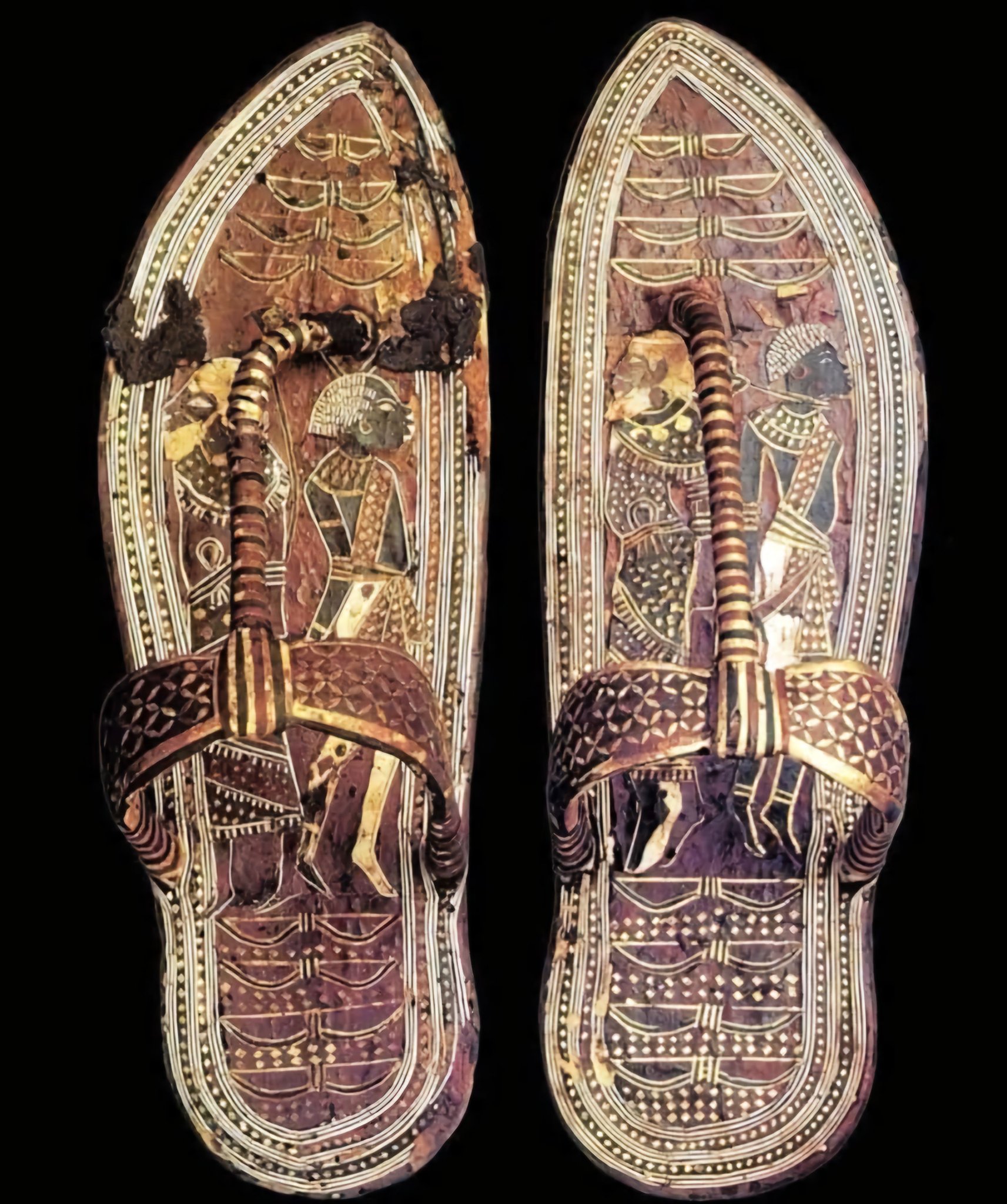“The discovery of Tutankhamun’s tomb in 1922, a moment that captivated the world, revealed a treasure trove of artifacts, each offering a window into the life and times of the young pharaoh. Among these treasures were his sandals, meticulously crafted and remarkably preserved, which served not merely as footwear but as symbolic objects for his journey into the afterlife. These sandals, alongside other artifacts, have played a crucial role in shaping our understanding of ancient Egyptian craftsmanship, royal customs, and the complex life of a ruler whose legacy far outlived his brief reign.”
A Glimpse into Royal Craftsmanship: Objects for the Afterlife
- Crafted for Eternity:
- Tutankhamun’s sandals were not ordinary footwear; they were carefully designed and crafted objects intended for his use in the afterlife. The intricate details and high-quality materials used in their construction reveal the skill and artistry of ancient Egyptian artisans.
- The placement of such objects in the tomb underscores the Egyptian belief in an afterlife where the deceased would continue their earthly existence. These sandals, therefore, were essential for Tutankhamun’s journey into eternity.
- Symbolism and Royal Customs:
- The sandals also offer insights into the royal customs of ancient Egypt. The materials, design, and placement of these objects within the tomb were carefully considered, reflecting the pharaoh’s status and the rituals surrounding death and burial.
- These artifacts, therefore, serve as tangible evidence of the elaborate preparations made for a pharaoh’s passage into the afterlife, highlighting the importance of ensuring a smooth transition for the ruler.
- The Tomb’s Significance:
- The discovery of Tutankhamun’s nearly intact tomb was an archeological marvel, providing a rare glimpse into the burial practices and material culture of ancient Egypt’s New Kingdom. The sandals, among other treasures, contributed significantly to our understanding of this period.
- The sheer quantity and quality of the artifacts found within the tomb have made Tutankhamun one of the most iconic figures of ancient Egyptian history.
The Young Pharaoh’s Life and Legacy: A Reign Marked by Tragedy
- A Brief and Turbulent Reign:
- Tutankhamun ascended to the throne at a young age and died around 18 years old, his short reign marked by political transition and personal tragedy. The period was one of significant change, as Egypt sought to recover from the religious upheaval caused by his father, Akhenaten.
- His reign, though brief, played a crucial role in restoring the traditional Egyptian religion, reversing the monotheistic reforms of Akhenaten.
- Genetic Insights and Family History:
- Modern DNA analysis has revealed that Tutankhamun’s health was compromised by genetic issues, likely exacerbated by inbreeding. His parentage, the result of a union between Pharaoh Akhenaten and his own sister, the “Younger Lady,” has shed light on the royal family’s complex dynamics.
- The genetic findings have not only provided insights into Tutankhamun’s health but also offered a deeper understanding of the royal lineage and the practices of the time.
- Enduring Legacy:
- Despite his short reign and tragic life, Tutankhamun’s legacy has endured, largely due to the remarkable preservation of his tomb and its contents. The sandals, along with the other artifacts, have played a significant role in cementing his place in history.
- The artifacts have allowed historians and archeologists to piece together a more comprehensive picture of ancient Egyptian royal life, religious beliefs, and artistic achievements.
Implications and Historical Context: Unraveling Ancient Mysteries
- Ancient Egyptian Craftsmanship:
- The sandals, along with other artifacts from the tomb, showcase the high level of craftsmanship achieved by ancient Egyptian artisans. The intricate details and use of precious materials highlight their skill and artistry.
- These objects provide valuable insights into the techniques and materials used in ancient Egyptian art and craftsmanship, contributing to our understanding of their technological capabilities.
- Royal Burial Practices:
- The elaborate preparations for Tutankhamun’s burial reflect the importance of ensuring a smooth transition into the afterlife for a pharaoh. The inclusion of personal items, such as sandals, was intended to equip him for his journey.
- The artifacts found in the tomb offer a comprehensive view of the burial rituals and beliefs surrounding death in ancient Egypt, shedding light on their spiritual worldview.
- Historical Significance:
- Tutankhamun’s tomb and its contents have become invaluable resources for historians and archeologists studying ancient Egypt. They provide a direct link to a pivotal period in Egyptian history.
- The artifacts have allowed researchers to reconstruct aspects of daily life, religious practices, and political events, contributing to a more nuanced understanding of this ancient civilization.
Conclusion:
“Tutankhamun’s sandals, discovered within his remarkably preserved tomb, stand as more than just ancient footwear. They are symbolic artifacts that offer a glimpse into the craftsmanship, royal customs, and beliefs of ancient Egypt. The sandals, along with the other treasures found in the tomb, have ensured Tutankhamun’s enduring legacy, transforming him into one of the most iconic figures of ancient history. His short reign, marked by tragedy and political transition, has been overshadowed by the enduring fascination with the artifacts that accompanied him into eternity, providing a lasting testament to a civilization that continues to captivate the world.”

CÁC TIN KHÁC
Mary Walton: The Forgotten Inventor Who Helped Clean Up America’s Cities
Tomb of Queen Nefertari in the Valley of the Queens, Egypt
Discover the Hypostyle Hall of the Temple of Hathor at Dendera
Venus de Losange: Unveiling the Mystery of a 20,000-Year-Old Paleolithic Icon